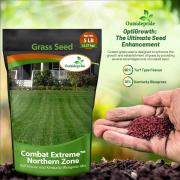Mowing: We often forget that a lawn is actually hundreds of individual plants growing together in a confined space. When you remove the tops of the plants, you are encouraging fescue clumps to spread laterally and produce a thicker lawn. At the same time, you are trimming uneven growth so that all the individual plants appear to be growing in unison at the exact same rate.
When you head out into the yard to mow, remember that fescue is a very different kind of grass from warm-season grasses like Bermuda grass. It grows in a clump, does not spread by rhizomes and stolons, and has a some-what delicate growing point called a “crown” at the base of the grass blades. Unlike the warm-season grasses, it is disastrous if you scalp a fescue lawn at any time during the year. If you keep your mowing heights above 2.5 inches at all times, however, you will be fine.
Recommended Mowing Heights
Type of Fescue Mow to: Mow when grass is:
Kentucky-32 Tall fescue 3-4 4.5-6
Turf-type tall fescue 2.5-3 3.75-4.5
Creeping Red fescue 2-2.5 3-3.75
When you head out into the yard to mow, remember that fescue is a very different kind of grass from warm-season grasses like Bermuda grass. It grows in a clump, does not spread by rhizomes and stolons, and has a some-what delicate growing point called a “crown” at the base of the grass blades. Unlike the warm-season grasses, it is disastrous if you scalp a fescue lawn at any time during the year. If you keep your mowing heights above 2.5 inches at all times, however, you will be fine.
Recommended Mowing Heights
Type of Fescue Mow to: Mow when grass is:
Kentucky-32 Tall fescue 3-4 4.5-6
Turf-type tall fescue 2.5-3 3.75-4.5
Creeping Red fescue 2-2.5 3-3.75
Once you have determined the correct mowing height for your type of fescue, mow consistently! If you mow at the right height and at the right time, your grass clippings will never be more than a couple of inches long. Clippings of this size will fall to the soil surface and decompose quickly without building a layer of thatch.






































